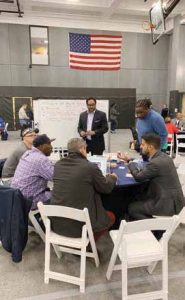Bridging Gaps through Innovation
 On November 16-17, 2018, the hackathon “Bridging Gaps through Innovation,” developed by the American Association of Blacks in Energy (AABE) and Breakthrough Marketing Technology, in partnership with the NYU Tandon School of Engineering and National Grid, took place at the NYU Tandon School of Engineering. This hackathon was a novel process that combined inclusion and cross-disciplinary thinking to develop innovate solutions for complex problems. Professionals, business leaders, academics, students, data scientists, policy makers, and people from the community came together to work on discrete challenges where design thinking and technology were factors that could be applied to the solution.
During the event, Steve Mitnick of Public Utilities Fortnightly met with Breakthrough CEO Pam Roach and Senior Partner Larry Glover to discuss Breakthrough’s role in the hackathon.
On November 16-17, 2018, the hackathon “Bridging Gaps through Innovation,” developed by the American Association of Blacks in Energy (AABE) and Breakthrough Marketing Technology, in partnership with the NYU Tandon School of Engineering and National Grid, took place at the NYU Tandon School of Engineering. This hackathon was a novel process that combined inclusion and cross-disciplinary thinking to develop innovate solutions for complex problems. Professionals, business leaders, academics, students, data scientists, policy makers, and people from the community came together to work on discrete challenges where design thinking and technology were factors that could be applied to the solution.
During the event, Steve Mitnick of Public Utilities Fortnightly met with Breakthrough CEO Pam Roach and Senior Partner Larry Glover to discuss Breakthrough’s role in the hackathon. PUF: You’re both playing a major role at this AABE hackathon. How did you get involved and what are you doing here?
Larry Glover: We’ve been involved in the energy industry for quite some time, and we’ve seen the transition from focus on energy products to focus on end user engagement. AABE is our client and we talked to them about new ways to bring innovation to the industry. We used our experience with hackathons to build a program specifically for AABE. We’ve modeled it after some of the better hackathons that have been done around the country. We started building hackathons with another colleague of ours at MIT.
What makes this hackathon different is the ability to combine industry practitioners with other stakeholders around energy, whether they be community organizations, MWBE [minority and women-owned business enterprises] or policymakers. We were particularly sensitive in including our student universe. When you start to hack issues about workforce, for example, we must have students engaged, because they are the future workforce we’re talking about. When the challenge is making solar available in urban communities, those community partners must be part of the conversation because they are the end users. If we don’t design it so that the end user understands and benefits from the exercise, it raises the question, is this academic for AABE and for this industry? It can’t just be academic.
PUF: You give to this hackathon, but your firm Breakthrough takes something from it. Describe this?
Larry Glover: We have a lot of experience understanding communities of color, and low-income communities. We have experience with African-American communities, Latino communities, and Asian communities. Within those ethnicities, there are a number of sub-segments that determine how people behave, how people respond to the offers they receive from energy companies. The way we collect end user information is by engaging the end user. We go and spend time with them in-person and digitally. We do interviews. We do fieldwork to observe. Then we’re able to understand, not just what end users say, but what’s underneath. How they think? How they feel? We can capture the words to use to be motivating, to get them to adopt a new energy related behavior. That, in the long run, is in the best interest of the end user, because it resonates with their long-term objectives.
When you talk to companies who have a footprint in a region with one or two or three million customers, they need to know “How do you discern the differences between them?” It’s not just how you define their differences, but how to define their ability to participate in the process. Take, for example, solar. We understand that there are two communities that are affected, the haves and the have-nots. Today, it is the haves who have the ability to take advantage of the solar opportunity. But when they go off conventional usage on the grid, the have-nots now have to shoulder a great share of the support of the grid, because it’s a static cost. As we help the companies understand who these groups are and what their needs are, it also is imperative to share those insights in our conversations with legislators and policy makers, because they are now responsible for balancing the needs and opportunities of everyone to ensure that solar is not disproportionally affecting low income or the have-nots. That’s part of what we bring to our clients and to our companies—understanding not just their customers, but how their business impacts each of us.
PUF: How did you decide to do that?
Pam Roach: It was partly the evolving needs of the market. Fundamentally, as a marketer, you must understand your target customer and find a way to communicate to them with a context that they understand. The more you know about them, the better you can communicate—just like the more you know about your spouse, the better can communicate with him or her. It’s the same principle, on a larger scale.
When it comes to trying to understand how to learn about your target customer, that’s where data science comes in. That’s where big data comes in. That’s where descriptive statistics come in. It’s a tool to help us figure out how to communicate more effectively to motivate new behavior.
The only reason all that technical stuff matters is that it is the way energy companies can achieve end user relevance.
PUF: You’ve studied segments of customers and communities.
Pam Roach: What we take from it is a deeper understanding of the different end user groups. What drives customers is not just the demographics. A traditional starting point of energy companies, and even those outside the sector, is their sales data. They use it to learn about their customers. That tells you what and how much they bought, then paid, and it gives you information about their demographics. To understand customers requires information beyond demographics. An age, where they live, their education, is not the whole story. It’s not what determines their behavior. It’s not what makes them receptive to an energy efficiency program. Or decide to pursue a career in energy versus other careers for talented individuals.
What we get out of this is a deeper understanding of the communities. In fact, that is what one of the hackathon winning teams did. At 7:00 a.m. on a Saturday morning, they went to a nearby New York Housing Authority housing project and interviewed residents. They collected data about their feelings and attitudes about energy efficiency and their utility.
Breakthrough uncovers information about the uses of energy. We ask, “What are their aspirations? How do those aspirations relate to energy? What does the energy sector need to do to connect with them?” Because every one of those energy companies, the utilities, is aware of the importance of being driven by the customer, by the marketplace.
But sometimes, energy companies don’t know enough about their customers, and don’t know how to learn enough to meet their objectives. We see this as opportunity, a challenge. Our approach is often new to them. We generate insights that help them refine what they offer customers and their communications to them.
Larry Glover: We think about this in two ways. It’s input and output. The input is what we’re able to gather about the end user through processes and the new ideas that come from them. We make that information relevant to what the energy company can deliver. The output is the definition and communication about the new offers that are meaningful to the end user, to the customer.
Pam Roach: What we do at Breakthrough is transform data from static, demographic, psychographic, and sociology, to effective communications. It’s how we engage our clients, so they are more knowledgeable, and understand what’s required to take best advantage of these opportunities. We look at it as input and output. We are the output side. We create that connection to customers.





